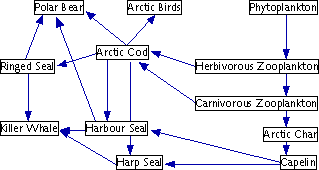Difference between revisions of "Food chain" - New World Encyclopedia
Rick Swarts (talk | contribs) (Added atricle and credit tags) |
|||
| Line 1: | Line 1: | ||
| + | {{Contracted}} | ||
'''Food chains''' and '''food webs''' or '''food networks''' describe the feeding relationships between species in a [[biocoenosis|biotic community]]. In other words, they show the transfer of material and energy from one species to another within an [[ecosystem]]. | '''Food chains''' and '''food webs''' or '''food networks''' describe the feeding relationships between species in a [[biocoenosis|biotic community]]. In other words, they show the transfer of material and energy from one species to another within an [[ecosystem]]. | ||
Revision as of 22:32, 10 May 2006
Food chains and food webs or food networks describe the feeding relationships between species in a biotic community. In other words, they show the transfer of material and energy from one species to another within an ecosystem.
As usually diagrammed, an organism is connected to another organism for which it is a source of food energy and material by an arrow representing the direction of biomass transfer. Organisms are grouped into trophic levels—from the Greek for nourishment, trophikos—based on how many links they are removed from the primary producers. Primary producers, or autotrophs, are species capable of producing complex organic substances (essentially "food") from an energy source and inorganic materials. These organisms are typically photosynthetic plants or algae, but in rares cases, like those organisms forming the base of deep-sea vent food webs, can be chemotrophic. All organisms that eat the autotrophs are called heterotrophs. They get their energy by eating the producers.
Food chain
A food chain describes a single pathway that energy and nutrients may follow in an ecosystem. There is one organism per trophic level, and trophic levels are therefore easily defined. They usually start with a primary producer and end with a top predator. Here is an example of a food chain:
- phytoplankton → copepod → fish → squid → seal → Orca
This "chain" can be described as follows: Killer whales (Orca) feed upon seals, that feed upon squid, that eat small fish, that feed on copepods, that feed on microscopic algae. In this example, algae—autotrophs by virtue of their ability to photosynthesize—are the base of the food chain. It is always the case that numbers—or at least biomass—decreases from the base of the chain to the top. In other words, the number and mass of phytoplankton cells is much greater than the number and mass of copepods being supported by the phytoplankton. Viewed another way: to support one Orca requires many seals, large numbers of squid, huge numbers of fish, and so on down the chain (see energy pyramid). Food chains are overly simplistic as representatives of what typically happens in nature. The food chain shows only one pathway of energy and material transfer. Most consumers feed on multiple species and are, in turn, fed upon by multiple other species. The loss of energy through the levels causes the species at the top to be less numerous. On average 10% of the organism's energy is passed on to its predator.
Food web
A food web or food network extends the food chain concept from a simple linear pathway to a complex network of interactions. The direct steps as shown in the food chain example above seldom reflect reality. This "web" makes it possible to show much bigger animals (like a whale) eating very small organisms (like plankton). Food sources of most species in an ecosystem are much more diverse, resulting in a complex web of relationships as shown in the figure on the right. In this figure, the grouping of Phytoplankton → Herbivorous zooplankton → Carnivorous zooplankton → Arctic char → Capelin on the far right is a food chain; the whole complex network is a food web/network.
External links
- Antarctic Food Web and Chains
- [1]example of a food chain
See also
- Bioaccumulation
- Soil food web
Credits
New World Encyclopedia writers and editors rewrote and completed the Wikipedia article in accordance with New World Encyclopedia standards. This article abides by terms of the Creative Commons CC-by-sa 3.0 License (CC-by-sa), which may be used and disseminated with proper attribution. Credit is due under the terms of this license that can reference both the New World Encyclopedia contributors and the selfless volunteer contributors of the Wikimedia Foundation. To cite this article click here for a list of acceptable citing formats.The history of earlier contributions by wikipedians is accessible to researchers here:
The history of this article since it was imported to New World Encyclopedia:
Note: Some restrictions may apply to use of individual images which are separately licensed.
